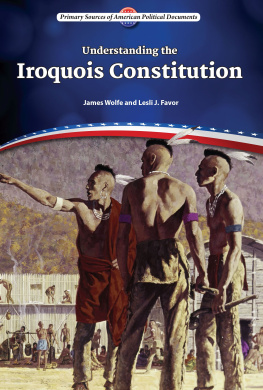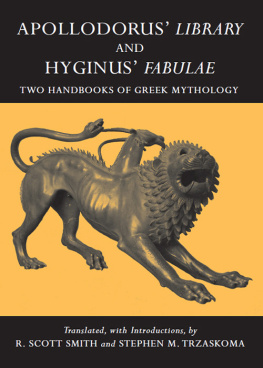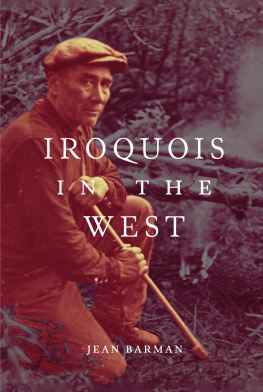Chapter I.
Gods and Other Supernatural Beings
The principal monuments of the once powerful Iroquois are their myths and folk-lore, with the language in which they are embodied. As these monuments are fast crumbling away, through their contact with European civilization, the ethnologist must hasten his search among them in order to trace the history of their laws of mind and the records of their customs, ideas, laws, and beliefs. Most of these have been long forgotten by the people, who continue to repeat traditions as they have been handed down through their fathers and fathers' fathers, from generation to generation, for many centuries.
The pagan Iroquois of to-day (and there are still many) will tell you that his ancestors worshiped, as he continues to do, the "Great Spirit," and, like himself, held feasts and dances in his honor; but a careful study of the mythology of these tribes proves very clearly that in the place of one prevailing great spirit (the Indian's earliest conception of the white man's God) the Iroquois gods were numerous. All the mysterious in nature, all that which inspired them with reverence, awe, terror, or gratitude, became deities, or beings like themselves endowed with supernatural attributes, beings whose vengeance must be propitiated, mercy implored, or goodness recompensed by thank-offerings. The latter were in the form of feasts, dances, or incense.
Among the most ancient of these deities, and regarding which the traditions are the most obscure, were their most remote ancestorscertain animals who later were transformed into human shape, the names of the animals being preserved by their descendants, who have used them to designate their gentes or clans.
Many races in that particular stage of savagery when the human intellect is still in its child-like state, being impressed by the awful and incomprehensible power of Thunder, have classed it foremost among their deities, with attributes proportioned to the disposition or status of the worshiper.
Hi-nu, the beneficent Thunder God of the Iroquois, compares most favorably with the same god as worshiped by other races. Ever accompanied by his equally powerful assistants, his mission was understood to be only to promote the welfare of that favored people, though isolated personal offenses might demand from him a just retribution. It was therefore safe to make unto him, on his near approach to earth, his most acceptable offering, the burning tobacco, and so firmly rooted has become that ancient custom, that the aged superstitious Iroquois of to-day can often be seen making this little offering on the near approach of every thunder-storm. It is not difficult to follow the crude reasoning by which was ascribed to Hi-nu the goodness and glory of having destroyed the giant monsters which either poisoned the waters or infested the land. That such had existed was evident from the bones often discovered, and what power other than the crashing bolt of Hi-nu could have accomplished their destruction? The similarity discoverable in the myths of many peoples regarding the Thunder God and his mission of destruction to giant animals, making this an almost universal myth, is probably traceable to this simple and natural explanation, and presents no argument that the myth itself has traveled. It may, then, be safely assumed that Hi-nu was an indigenous god of the Iroquois, the product of their own crude reasoning powers.
Brother of the great Hi-nu was the West Wind, who, with him, brought from the clouds the vivifying rain, and who finally assisted the Iroquois in the extermination of the powerful stone giants. Therefore, the West Wind ranks as a beneficent deity or spirit.
The North Wind brought only calamity in its train, often killing the unripe corn and freezing the rivers, thus depriving the people of their needed sustenance, and from the mere touch of his icy fingers the benighted hunter became stiff in death. This ranked as an evil deity ever to be feared and propitiated.
Echo, the Mars of the Iroquois, only exercised his power during their wars with other tribes, in which, by repeating among the hills their cries of Go-weh, he insured their almost certain victory. He was ever honored with special thanksgiving.
Of T-rhu-hyi-wh-ku (who bore the important office of Holder of the Heavens) there is little more known than that he brought out from their mother earth the six tribes composing the Iroquois.
These are some of the Iroquois gods, a knowledge of whose existence is contained only in myths, for they belong to the charmed "mythologic age." As, however, the Iroquois tribes have not entirely passed the boundaries of that age, it is proper to mention some of their more modern divinities, in whose worship are intermingled many of their ancient ceremonies.
The "Great Spirit," so popularly and poetically known as the god of the red man, and the "Happy Hunting-ground," generally reported to be the Indian's idea of a future state, are both of them but their ready conception of the white man's God and Heaven. This is evident from a careful study of their past as gleaned from the numerous myths of their prehistoric existence.

PL. XIIRETURNING THANKS TO THE GREAT SPIRIT.
It may be true that many of the first missionaries found them in possession of such ideas, but the Indians had long been in contact with white men from whom those ideas were obtained, and there was no incongruity in simply adding them to their former beliefs, as no fundamental change was required. They accepted the Great Spirit, but retained in many instances their former gods as his attributes, considering the thunder as his voice and the winds as his breath, and at the same time they introduced into their pagan worship a form of the trinity which is still preserved, consisting of the Great Spirit, the Sun, and Mother Earth.
Good and evil spirits also play an important rle in Iroquoian mythology. Among the good spirits are the three sisters who still continue to preside over the favorite vegetablescorn, beans, and squashes. They are represented as loving each other very dearly and dwelling together in peace and unity. The vines of the vegetables grow upon the same soil and cling lovingly around each other. The spirit of corn is supposed to be draped with its long leaves and silken tassels. The sister who guards the bean has a wreath of its velvety pods with garments of the delicate tendrils, while the spirit of squashes is clothed with the brilliant blossoms under her care. In bright nights the sisters can be seen flitting about or heard rustling among the tall corn. To this day yearly festivals are held in their honor, and they are appealed to as "Our life, our supporters."
Among the supernatural beings corresponding to good and evil genii were the Great Heads, with ever watchful eyes, and long hair which served them as wings to bear them on missions of mercy or of destruction. This pure product of the Indian imagination figures largely in the unwritten literature of the Iroquois. There were also in those days stone giants, always the mortal enemy of man, but whose final extermination furnished the theme for wonderful stories of daring deeds performed oftentimes under the influence of charms or magic, but never in too marvelous a manner to disturb the credulity of the eager listener.












